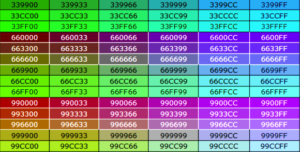What Are Color Codes? What Types of Color Codes Are There?
In the digital world and design field, accurately representing colors is crucial for both aesthetic and functional purposes. In this context, color codes allow colors to be standardized and defined in a digital format. So, what are color codes and what types of color codes are used? In this article, we will explore the definition, types, and applications of color codes in detail.
What Are Color Codes?
Color codes are systems that enable colors to be expressed in a specific format in digital environments. These codes are used to display colors consistently on computer screens, websites, mobile applications, and other digital media platforms. They allow for the precise definition of colors, ensuring that designers and developers use colors consistently.
Color codes are generally expressed in various formats such as hexadecimal (hex) codes, RGB (Red, Green, Blue) values, CMYK (Cyan, Magenta, Yellow, Black) values, and HSL (Hue, Saturation, Lightness) values. Each format defines colors in a different way and serves different purposes.

Types of Color Codes
There are various types of color codes, each with different characteristics. Here are the most common types of color codes:
- Hexadecimal (Hex) Codes: Hex codes represent colors with a six-character alphanumeric code. These codes usually start with a # symbol, followed by six characters that represent the color components. For example, #FF5733 represents the color orange. Hex codes are widely used in web and graphic design.
- RGB Codes: RGB codes define colors based on the mixture of red (Red), green (Green), and blue (Blue) components. Each component can have a value between 0 and 255. For instance, the RGB(255, 87, 51) code represents the same orange color. RGB codes are used for color definition on digital screens.
- CMYK Codes: CMYK codes describe colors as a mix of cyan (Cyan), magenta (Magenta), yellow (Yellow), and black (Key) components. These codes are typically used in printing processes and represent how colors are mixed on paper. For example, the CMYK(0, 72, 93, 0) code can represent a specific shade of orange.
- HSL Codes: HSL codes define colors as a combination of hue (Hue), saturation (Saturation), and lightness (Lightness) components. Hue determines the color itself, saturation indicates the intensity of the color, and lightness describes the shade of the color. For example, the HSL(11, 100%, 60%) code represents the color orange.
Where Are Color Codes Used?
Color codes are used across various digital and print media platforms. Here are some common applications:
- Web Design: Color codes are used to ensure that colors are applied consistently and aesthetically on websites. Designers use color codes for elements like background colors, text colors, and button colors to create a cohesive and professional look.
- Graphic Design: In graphic design projects, color codes ensure that graphics and illustrations are colored accurately. Color codes are crucial for consistent use of colors in logo design, brochures, posters, and other graphic materials.
- Printing Processes: CMYK codes help achieve accurate colors in printing. Color codes assist in adjusting color profiles sent to printing machines, ensuring that printed results match digital designs.
- Mobile App Design: In mobile apps, color codes are used to define the colors of user interface (UI) elements. This ensures a consistent and aesthetically pleasing appearance for the app and enhances the user experience.
How to Choose Color Codes?
When selecting color codes, there are several factors to consider:
- Color Harmony: It is important for colors to be combined harmoniously. Understanding color theory and color constraints can make your color selection more effective.
- Target Audience: Consider the cultural and psychological color perceptions of your target audience. Some colors may evoke specific emotions and associations.
- Media Type: Determine whether colors will be used on digital screens or in print. Color codes may differ for digital and printed media.
Conclusion
Color codes ensure that colors are accurately and consistently defined in digital design and print media. Formats like Hex, RGB, CMYK, and HSL provide various ways to express colors and facilitate design processes. Proper use of color codes helps achieve aesthetically pleasing and functional projects. By using color codes effectively, you can ensure that your designs appear professional and cohesive.




